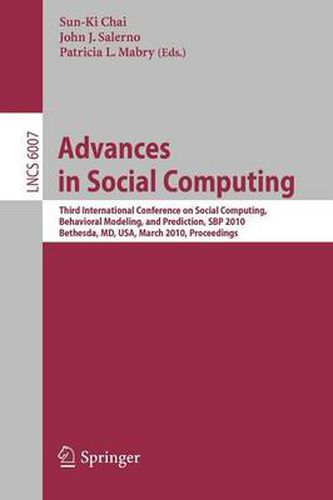Readings Newsletter
Become a Readings Member to make your shopping experience even easier.
Sign in or sign up for free!
You’re not far away from qualifying for FREE standard shipping within Australia
You’ve qualified for FREE standard shipping within Australia
The cart is loading…






This title is printed to order. This book may have been self-published. If so, we cannot guarantee the quality of the content. In the main most books will have gone through the editing process however some may not. We therefore suggest that you be aware of this before ordering this book. If in doubt check either the author or publisher’s details as we are unable to accept any returns unless they are faulty. Please contact us if you have any questions.
Social computing is concerned with the study of social behavior and social context based on computational systems. Behavioral modeling provides a representation of the social behavior, and allows for experimenting, scenario planning, and deep und- standing of behavior, patterns, and potential outcomes. The pervasive use of computer and Internet technologies by humans in everyday life provides an unprecedented en- ronment of various social activities that, due to the platforms under which they take place, generate large amounts of stored data as a by-product, often in systematically organized form. Social computing facilitates behavioral modeling in model building, analysis, pattern mining, and prediction. Numerous interdisciplinary and interdepe- ent systems are created and used to represent the various social and physical systems for investigating the interactions between groups, communities, or nation-states. This requires joint efforts to take advantage of the state-of-the-art research from multiple disciplines improving social computing and behavioral modeling in order to document lessons learned and develop novel theories, experiments, and methodologies to better explain the interaction between social (both informal and institutionalized), psyc- logical, and physical mechanisms. The goal is to enable us to experiment, create, and recreate an operational environment with a better understanding of the contributions from each individual discipline, forging joint interdisciplinary efforts. This volume comprises the proceedings of the third international workshop on - cial Computing, Behavioral Modeling and Prediction, which has grown trem- dously.
$9.00 standard shipping within Australia
FREE standard shipping within Australia for orders over $100.00
Express & International shipping calculated at checkout
This title is printed to order. This book may have been self-published. If so, we cannot guarantee the quality of the content. In the main most books will have gone through the editing process however some may not. We therefore suggest that you be aware of this before ordering this book. If in doubt check either the author or publisher’s details as we are unable to accept any returns unless they are faulty. Please contact us if you have any questions.
Social computing is concerned with the study of social behavior and social context based on computational systems. Behavioral modeling provides a representation of the social behavior, and allows for experimenting, scenario planning, and deep und- standing of behavior, patterns, and potential outcomes. The pervasive use of computer and Internet technologies by humans in everyday life provides an unprecedented en- ronment of various social activities that, due to the platforms under which they take place, generate large amounts of stored data as a by-product, often in systematically organized form. Social computing facilitates behavioral modeling in model building, analysis, pattern mining, and prediction. Numerous interdisciplinary and interdepe- ent systems are created and used to represent the various social and physical systems for investigating the interactions between groups, communities, or nation-states. This requires joint efforts to take advantage of the state-of-the-art research from multiple disciplines improving social computing and behavioral modeling in order to document lessons learned and develop novel theories, experiments, and methodologies to better explain the interaction between social (both informal and institutionalized), psyc- logical, and physical mechanisms. The goal is to enable us to experiment, create, and recreate an operational environment with a better understanding of the contributions from each individual discipline, forging joint interdisciplinary efforts. This volume comprises the proceedings of the third international workshop on - cial Computing, Behavioral Modeling and Prediction, which has grown trem- dously.